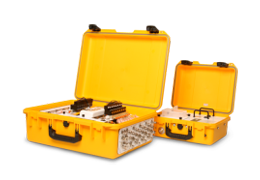Carbon dioxide in the soil is produced by respiration from plant roots and microorganisms surrounding the roots, and from heterotrophic microorganisms that metabolize plant litter and soil organic matter. In some soils, CO2 is also generated by the action of rainwater on calcareous substrates. Temperature and moisture are important drivers of these processes.
Carbon dioxide moves from the sites of production to the atmosphere primarily by diffusion through air-filled pores and cracks in the soil, but it can also be driven by local changes in pressure due to wind or volumetric displacement by rain. The air- filled porosity of the soil varies with soil type and moisture content, so these characteristics can have a significant effect on CO2 movement in the soil.
Measuring carbon dioxide flux from soils
The LI-8100A uses the rate of increase of CO2 in a measurement chamber to estimate the rate at which CO2 diffuses into free air outside the chamber. For such an estimate to be valid, conditions must be similar inside and outside the chamber. These conditions include the concentration gradient driving diffusion, barometric pressure, temperature, and moisture of the soil.
The CO2 gradient between the soil surface layer and air are not exactly the same inside and outside the chamber, because there is an increase in CO2 mole fraction inside the chamber. The diffusion rate is estimated and corrected for this using an analytical technique that takes into account the effects of increasing chamber CO2 concentration on the diffusion gradient. This makes it possible to estimate the initial rate of CO2 increase that occurred immediately after the chamber closed.
It is also important to consider the effect of the presence of the chamber on CO2 gradients within the soil. Detailed diffusion model studies have shown that chambers can alter gas concentration gradients in the soil, leading to errors in CO2 flux estimates (Healy, et al., 1996). We generally recommend limiting measurement times to 90 to 180 seconds in order to keep chamber CO2 concentration changes as small as possible, and minimize this effect.
Soil CO2 flux varies substantially in both space and time. The LI-8100A can be used to sample both types of variability. The survey chamber allows rapid measurements to be made at many sites and the long-term chamber supports automated, sequential measurements at a single site over time. Both chambers have carefully designed pressure vents to prevent pressure gradients and wind incursion from outside the chamber. Both chambers close automatically, minimizing mechanical disturbances during the measurement. The long-term chamber moves away from the soil measurement area when a measurement is not in progress. For example, if a 2-minute measurement is made once every 30 minutes, the soil will be fully exposed to sun, wind and precipitation more than 93% of the time. This is an important consideration to ensure that the moisture and temperature of the soil within the measurement collar are similar to the surrounding soil.
